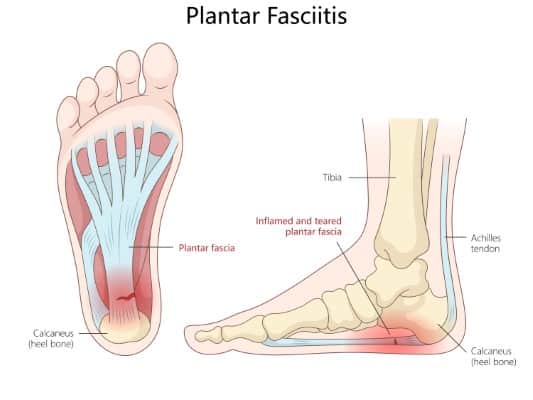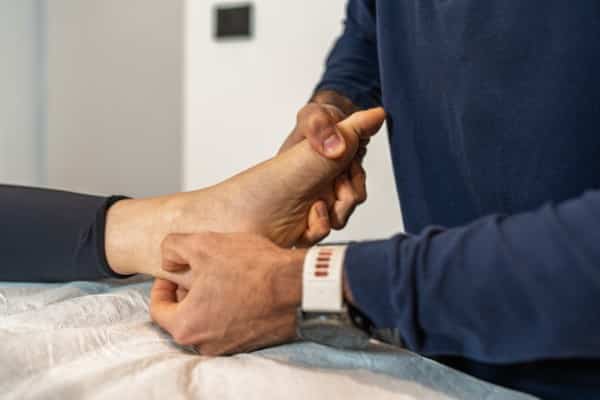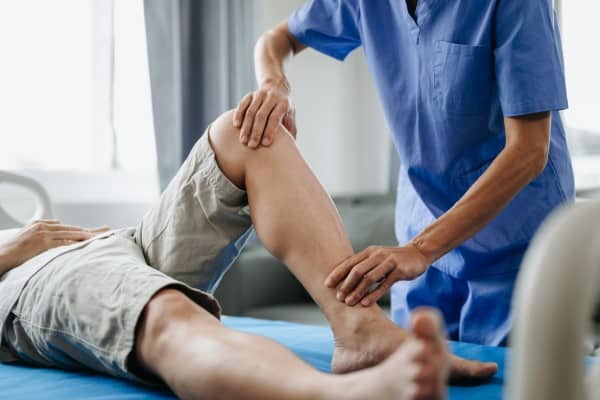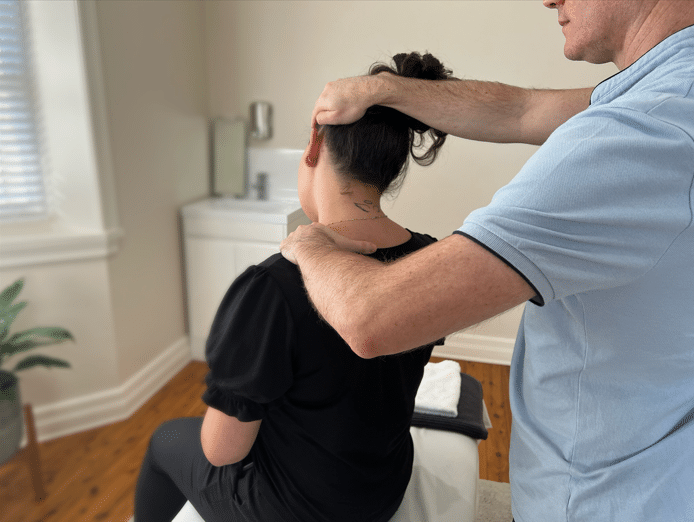- 02 9712 1736
- [email protected]
- 212 Great North Road, Five Dock, NSW 2046
- Open 7 days a week
That stabbing ache in your heel when you take your first steps in the morning is more than just a nuisance; it’s a call for help from your plantar fascia. If you are one of the millions who suffer from plantar fasciitis, you have probably thought, “Will this pain ever go away?” The good news is that you can find hope at the end of this sometimes long and painful journey with the right treatment and understanding
Plantar fasciitis, the painful inflammation of the tissue linking your heel to your toes, will eventually go away for approximately 80% of patients with correct treatment. Recovery usually takes 10 to 12 months and requires patience. The illness affects more than just your feet; it also changes how you move, which can cause hip and back pain as your body compensates. Treatment should address the whole-body relationship. The approaches vary from conservative (rest, ice, stretching) to intermediate (physical therapy, taping) to advanced (injections, surgery).
Osteopathic and chiropractic care provide valuable whole-body techniques that address the complete mechanical chain, not simply the foot. With constant treatment and sensitivity to your body’s signals, you will be able to move without discomfort again.
Don’t wait until your pain becomes chronic, set up a consultation with one of our foot health experts today to begin your personalised recovery plan and take the first step towards pain-free living!
Plantar fasciitis arises when the plantar fascia, a thick band of tissue that connects your heel to your toes, becomes irritated. This tissue supports the arch of your foot and serves as a shock absorber as you walk. When it’s damaged or irritated, each step might be a painful reminder that something is wrong.
The issue affects around 8% of Australians each year and accounts for thousands of all foot-related healthcare visits. It is most common among runners, the overweight, and those who wear shoes with insufficient support.

The answer to this crucial question varies. Plantar fasciitis is usually a temporary condition. According to research, around 80% of cases are resolved within 10 to 12 months. However, the timeframe and likelihood of total recovery are determined by a variety of circumstances.
How quickly you handle the issue can significantly reduce recovery time. Your commitment to treatment makes a significant difference, as adhering to suggested therapies is critical for healing. Diabetes and arthritis, for example, can make recuperation more difficult. Your activity level is important—continuing high-impact activities without change will postpone healing. And your weight is significant, as extra pounds place additional strain on the plantar fascia.
According to Dr. Sarah Johnson, a sports medicine podiatrist, plantar fasciitis is curable but requires patience. The tissue requires time to recover, and pushing through the pain can result in a chronic problem.”
Healing from plantar fasciitis does not usually happen overnight. A typical rehabilitation process progresses in stages, each with its own focus and objectives.
The initial phase, lasting about 2-3 weeks, focuses on lowering inflammation and pain. This includes relaxing and reducing pain-causing activities, learning basic stretching exercises, and applying ice to relieve pain. It is critical to let your foot begin the healing process.

During the initial healing period of 1-3 months, you will maintain consistent stretching routines while incorporating modest strengthening activities. This is also the time to address footwear issues and, if pain persists, look into more focused treatments. Your commitment during this time can have a huge impact on your long-term success.
The mid-recovery period, which lasts 3-6 months, allows you to develop more challenging exercises while gradually returning to previous activities. You will need to continue supporting measures such as the right footwear and stretching, but you should see significant improvement.
During the long-term healing phase, which lasts 6-12 months, the emphasis switches to maintaining healthy foot habits, monitoring for signs of recurrence, and continuing foot health-promoting exercises. This maintenance phase is critical to preventing future occurrences.
Dr. Robert Chen, an orthopaedic medicine expert, says that the plantar fascia recovers slowly due to its inadequate blood supply. This is why patience and consistency in treatment are critical.”

Plantar fasciitis develops into a chronic problem in approximately 20% of cases. Several things may contribute to this recurring condition. Delayed therapy worsens inflammation and causes tissue degeneration, making healing more difficult. Inconsistent treatment (beginning and stopping therapies) prevents total recovery. Due to underlying biomechanical difficulties, certain foot types are predisposed to reoccurring plantar fasciitis. Lifestyle factors such as professions that require extended periods of standing or wearing unsuitable footwear can exacerbate the disease.
A 2018 study published in the Journal of Foot and Ankle Research discovered that participants who maintained their home exercise programme after initial improvement were 80% less likely to have a recurrence within two years. This highlights the need for continuing therapeutic procedures even when pain has subsided.
One of the most ignored features of plantar fasciitis is how it alters your movement patterns, resulting in a chain reaction of pain and dysfunction throughout your body.
When your foot hurts, you automatically adjust your weight to alleviate the pain. This seemingly tiny adjustment has a far-reaching impact on your entire musculoskeletal system. To avoid pain, you may unconsciously shift how your foot touches the ground, causing your ankles and knees to react to your new walking pattern. This can cause hip misalignment since you favour one side. Misaligned hips can twist your spine, causing lower back pain. Over time, your entire posture may alter to compensate, causing upper back and neck tension.

Dr. Lisa Martinez, a physical medicine specialist, adds, “I frequently encounter patients who come in with back pain only to learn that their problem began with untreated plantar fasciitis. The body is extremely interrelated, and discomfort in one region frequently presents in another.”
According to a study published in the Journal of Orthopaedic & Sports Physical Therapy, those with persistent plantar fasciitis are three times more likely to develop lower back pain in a year than those without foot problems.
You may be experiencing this chain reaction if you notice pain that appears to “travel” up from your feet to your back, hip pain on the same side as your affected foot, lower back stiffness (especially after periods of activity), discomfort when standing up after sitting, or uneven wear patterns on your shoes. These indicators indicate that your plantar fasciitis is impacting more than simply your feet.

To effectively treat plantar fasciitis, it is necessary to address not just the foot pain but also the complete mobility chain that is affected. A multifaceted approach produces the finest results.
Conservative treatments serve as the primary treatment option. These include rest and activity adjustment to relieve stress on the plantar fascia, 15-20 minutes of ice therapy several times each day, and stretching exercises for the plantar fascia, Achilles tendon, and calf muscles. Supportive footwear with enough arch support and cushioning is required, and many people benefit from night splints that keep the foot in a dorsiflexed position overnight. Orthotics—custom or over-the-counter inserts that support the arch—can also help.
Intermediate therapies may be required if conservative techniques do not provide adequate relief. Physical therapy provides professional instruction on exercises and manual approaches. Taping procedures can relieve strain on the plantar fascia, while anti-inflammatory therapies (whether over-the-counter or natural) can assist in reducing inflammation. Extracorporeal shock wave therapy stimulates healing in chronic illnesses by using sound waves.
Advanced treatments are reserved for persistent situations. Corticosteroid injections to reduce inflammation, platelet-rich plasma therapy, which uses your own blood components to promote healing, the Tenex procedure for minimally invasive tissue removal, or surgery in severe cases that do not respond to other therapies.
A 2020 systematic study in the American Journal of Sports Medicine discovered that integrating various therapy options led to quicker recovery rates than single-method approaches. This lends weight to the notion that a comprehensive strategy addressing all facets of the condition results in better outcomes.
When plantar fasciitis affects your entire biomechanical chain, treatments that target your complete body—not just your feet—are very beneficial.
Osteopathic physicians (DOs) are specially trained to assess how issues in one area of the body influence others. Their treatment for plantar fasciitis often includes physical therapy and hands-on techniques to restore mobility and function. Myofascial release relieves tension in the fascia throughout the body, whereas joint mobilisation targets limits in the foot, ankle, and adjacent joints. A complete biomechanical study identifies and corrects movement patterns, while holistic therapy approaches cover nutrition, sleep, and stress management.

Dr. Luis Thomsen, DO, explains, “In osteopathic medicine, plantar fasciitis is not merely a foot problem. We see it as an indication that the body’s mechanical system is out of equilibrium. By restoring normal movement across the kinetic chain, we frequently heal not only the foot pain but also the back and hip disorders that arose concurrently.”
Chiropractors focus on how the musculoskeletal system influences general health. Their approach frequently includes spinal manipulations to rectify misalignments that may contribute to abnormal gait. Extremity modifications affect the foot and ankle joints directly. Soft tissue treatments remove adhesions and scar tissue that may have formed. A complete gait analysis assesses and corrects walking patterns, while rehabilitative activities improve weak points in the kinetic chain.
A research study published in the Journal of Chiropractic Medicine discovered that individuals getting chiropractic care for plantar fasciitis experienced a 40% reduction in pain compared to those receiving only standard medical care. This shows that treating the complete body, rather than just the foot, may produce greater benefits.
According to Dr. Scott McEvoy, Chiropractor, correcting spinal misalignments and restoring adequate nerve function allows the body to heal more effectively. Many patients are astonished to learn that spinal adjustments can assist them in relieving foot pain.

According to current research and clinical experience, a holistic strategy to recovery from plantar fasciitis should address both immediate and long-term health issues.
In the short term, rest is essential—reduce activities that cause pain, particularly high-impact workouts. To minimise inflammation, apply ice therapy after exercise or whenever you feel pain. Wear supportive shoes around the house and avoid walking barefoot. Gentle stretches for your calves and plantar fascia should be done several times per day to maintain flexibility and encourage recovery.
During the first month, see a podiatrist, physical therapist, osteopath, or chiropractor for a comprehensive examination. Ice, anti-inflammatory medications, and rest can all help to reduce inflammation. Begin a mild stretching and strengthening regimen as directed by your healthcare physician. Evaluate all of your footwear to ensure proper support, and consider replacing shoes with insufficient cushioning or arch support.
As your condition improves over the next 2-6 months, continue to do increasingly strenuous stretches and strengthening routines.
Work with an expert to address concerns throughout your complete mobility chain, not just your feet. Gradually raise activity levels, slowly returning to former activities while taking appropriate safeguards. Keep track of your progress by recording pain levels and exercise tolerance, and alter your strategy as appropriate.
Long-term maintenance requires consistent supportive behaviours such as excellent footwear and regular stretching. Any recurrence should be addressed as soon as possible; do not disregard early warning indications of recurring pain. Maintain overall health by balancing your complete mobility system with suitable exercise. Prevent future episodes by identifying your risk factors and taking aggressive steps to treat them.
So, will plantar fasciitis finally disappear? For the majority of patients, the answer is yes, with adequate care and patience. The process may be longer than you would like, but recognising that rehabilitation affects not only your feet but your entire body will help you approach treatment more successfully.
Remember that plantar fasciitis affects more than just your plantar fascia; it also alters your gait, which can cause difficulties throughout your body. Addressing these secondary concerns with comprehensive therapy, including osteopathic or chiropractic techniques as needed, will help assure complete healing.
With the correct combination of patience, continuous therapy, and paying attention to your body’s signals, you may leave this terrible condition behind you and resume your favourite activities without discomfort.

Forest Lodge, Annandale, Glebe, Leichhardt, Balmain, Haberfield, Canada Bay, Rozelle, Rodd Point, Wareemba, Stanmore, Petersham, Lilyfield, Hunters Hill, Enfield, Cabarita, Mortlake, Rhodes, Burwood Heights, Birchgrove, Gladesville, Huntleys Point, Abbotsford, Ashfield, Croydon Park, Croydon, Chiswick, Russell Lea, Burwood, Strathfield, Concord, Drummoyne, North Strathfield, Liberty Grove, Dulwich Hill, Lewisham, Camperdown, Ashbury, Homebush, Homebush West, Woolwich, Henley, Summer Hill, Sydney Olympic Park

About
Five Dock Osteopathic & Chiropractic is located in Canada Bay, in Sydney’s Inner West. Servicing suburbs including Burwood, Croydon, Drummoyne, Five Dock, Haberfield, Concord, Abbotsford, Chiswick, Leichhardt, Wareemba, Russell Lea, Summer Hill, Strathfield.
Clinic hours
Monday, Tuesday, Thursday 7AM – 7PM
Wednesday, Friday 7AM – 6PM
Saturday 7AM – 2PM
Sunday 8AM – 2PM
Contact details